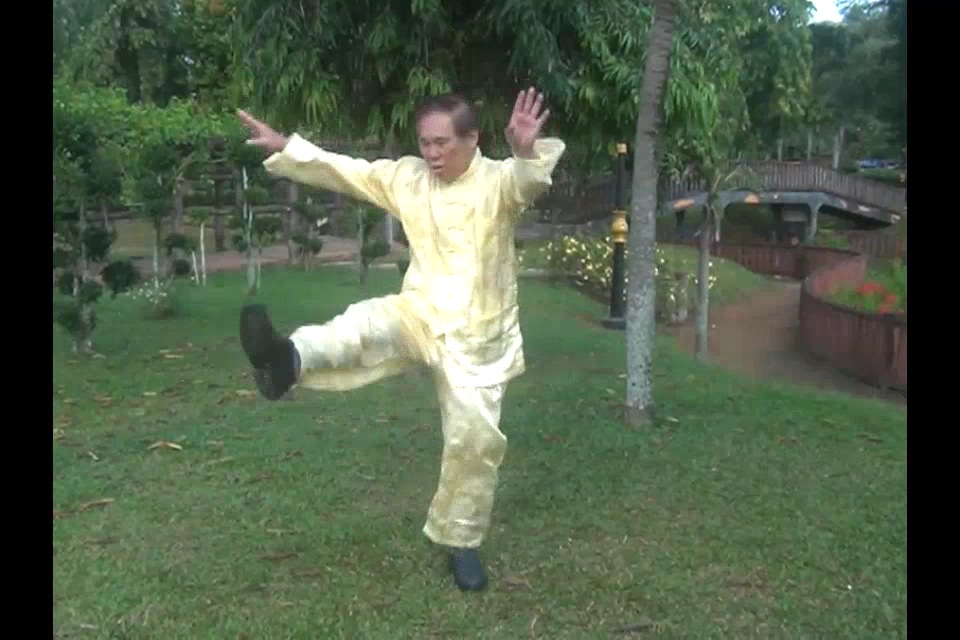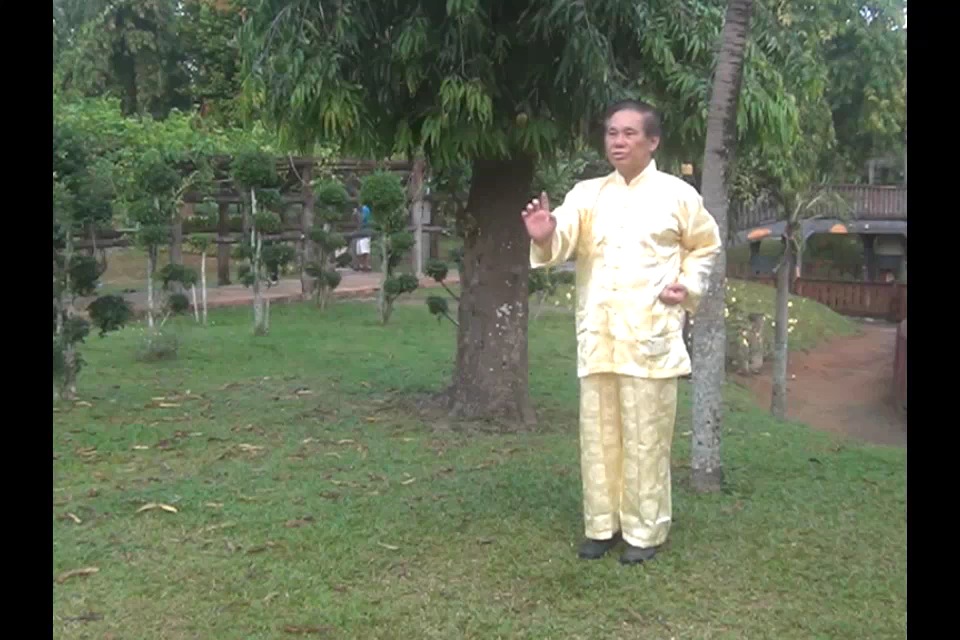VARIOUS TECHNIQUES OF TIGER-CRANE SET

Hungry Tiger Catches Goat
Question 3
Grand Master Lam Sai Wing's classical "Tiger and Crane" manual summarizes various techniques of the set:
Tiger Form: Seung Fu Jaau, Daan Fu Jaau, Wui Tau Fu, Jak Min Fu, Che Ma Fu, Cheut Saan Fu, Ha Saan Fu, Hoi San Fu
Crane Form: Baau Hok, Ngo Hok, Duk Geuk Fei Hok, Hok Chi, Hok Ding, Hok Jeui, Hok Jaau
Hung Ga Saam Jin Sau
Fat Ga Lo Hon Kyun
Would you be please so kind and explain some details regarding these techniques, their meaning, principles and application?
Sifu Pavel Macek
Answer
Grandmaster Lam Sai Weng’s classic, “Tiger-Crane”, is a great contribution to kungfu. I have benefitted very much from it.
I bought the classic when I was learning Shaolin Kungfu from Uncle Righteousness in the 1950s. I did not understand its depth then, I was only interested in the external forms of the set. It was much later when I had a better understanding of kungfu philosophy that I could derive more benefits.
The meaning, principle and application of the techniques are as follows.
“Seong Fu Jaau” means double tiger-claws. This technique is found in the pattern “Hungry Tiger Catches Goat”. The principle is to control an opponent with one tiger-claw and simultaneously attack him with the other.
It was recorded that “Hungry Tiger Catches Goat” was a favorite of Wong Fei Hoong. It is also one my favorites in all kungfu, not only in Tiger-Crane. I used this pattern often in my younger days of sparring and actual fighting.
The pattern can be used to counter any attack – be it striking, kicking, felling or gripping! If an opponent executes a punch or a kick, for example, I sink back to avoid it, immediately sweep away the attack and “tame” or control the opponent, and simultaneously counter attack his face, gripping his eyes or vital points.
If an opponent attempts to fell me, I move back my back leg to neutralize his leverage advantage, cover him with one tiger-claw preventing him from further strikes, move in my front leg into his stance, and attack his face with my other tiger claw. If he grip my one hand or two hands, I circulate my one or two hands to release the grip, rotating my waist for better momentum, cover him adequately, and counter-attack with my other tiger-claw.
There is a poetic couplet reminding practitioners the finer points of this pattern which sounds as follows in Cantonese:
-
Tzi ng seong fu ma tan yew
Di mei fok si mut hai kew
It means that when applying double tiger-claws one should slant forward his body in Bow-Arrow stance, and must not be negligent to tame the opponent adequately.
This explains why in the pattern the exponent’s body is slanting forward, and one arm is horizontally in front.
“Daan Fu Jaau” means single tiger claw. It is found in “Single Tiger Emerges from Cave”. Its principle is “lean” or “thap” in Cantonese, i.e. you “lean” your technique on an opponent’s attack, not block it as some students wrongly think.
There is no need to block an opponent’s attack because the defence is in the footwork. By move back your front leg to a False-Leg Stance, or shifting to a Seven-Star Stance in the Tiger-Crane Set, you have avoided the attack.
At an advanced stage, you do not just “lean’ your arm on the attacker’s arm, but also your tiger-claw on the attacker’s face from outside in, implementing the principle “kiew lei kiew seong ko”, which means “when there is a bridge, go over the bridge”.
“Wui Tau Fu” means return-head-tiger. The technique is found in the pattern “Golden Dragon Presents Claws”. Although it is called a “Golden Dragon”, it is actually a tiger-pattern using tiger-claws.
The principle is to trick an opponent to attack you from your back. You suddenly turn around and counter-strike him using the tactic of “no-defence-direct-counter”, i.e. you don’t need to defend against his attack, you just counter-strike him.
“No-defence” is a misnomer. Again, the defence is in the footwork. By turning around with your Unicorn Step, you have avoided his attack, and your attacking arm deflects it if the attack is still near. It also employs he principle of “when there is a bridge, go over the bridge”.
“Jak Min Fu” means side-face-tiger. This technique is found in the pattern “Fierce Tiger Crouching at Cliff”. The principle is facing your opponent from a side instead of frontally as it would be disadvantageous in the situation.
If an opponent grip your head with one hand and elbow your face with the other, as in some Muay Thai fighting, turn your face to a side and respond with “Fierce Tiger Crouching at Cliff”. You can release his grip, deflect his strike, and counter-strike him all at the same time!
“Che Ma Fu” means side-stance-tiger. This technique is found in the pattern “Guard Hand Sink Waist”. In Shaolin Wahnam, this same pattern is called “Black Tiger Guards Door”. The principle here is to turn your stance to a side for certain advantages as you attack your opponent.
For example, if an opponent attacks you with a right punch, you grip his right wrist with your right tiger-claw, turn your body to break his arm with your left shoulder and simultaneously grip his groin with your left tiger-claw.
“Cheut Saan Fu” means emerging-mountain-tiger. It can be found in the pattern “Fierce Tiger Pushes Mountain”. The principle is to employ a frontal attack. If an opponent rushes in to grab you, you can strike his solar plexus with your tiger-claw palm, as in this pattern.
“Ha Saan Fu” means “descending mountain tiger”. This technique is in the pattern “Fierce Tiger Descends Mountain”. As the term “descend” suggests, the tiger-claw movement is downward. Body-movement, with rotation of the waist, contributes to its successful application.
When an opponent attacks you with one hand or both hands, almost in any way, sink your body backward to avoid his attack, then rotate forward with downward movement of your tiger-claws, with the front claw attacking him and the back claw covering him to prevent him from countering.
“Hoi Saan Fu” means open-mountain tiger. This technique is found in the pattern “Double Bows Hand Strike”. In Shaolin Wahnam, this pattern is called “Double Bows Tame Tiger”. The combat principle is to open an opponent’s defence to strike him.
When you right hand is in contact with your opponent’s right hand, irrespective of their preceding movements, open your opponent’s defence by floating up his right elbow with your right hand, and strike his ribs with your left hand.
“Baau Hok” means well-fed crane. The technique is found in the pattern, “Reincarnated Well-Fed Crane”. The combat principle is to deflect an opponent’s attack, and simultaneously strike his eye. The feature of a well-fed crane is that its movements are performed leisurely.
Suppose an opponent grips your left wrist with his right hand. Almost effortlessly you release and control his right hand, and simultaneously strike his eye with your right crane beak.
“Ngo Hok” means hungry crane, The technique is found in “Hungry Crane Searches for Prawn”. Its principle is based on being quick and surprise.
In combat application, cover an opponent with one hand, and attack his groin with the other hand.
The way I perform this pattern is slightly different from what many people do. Instead of holding the five fingers together and pecking at an opponent’s groin, I swing my hand at his groin with my fingers initially open, close the fingers as I grip a testicle and quickly pull it out.
Although I perform this movement in solo practice, I haven’t used it in any real fights, and only an imitation in friendly sparring.
“Tok Geok Fei Hok” means “Single Leg Flying Crane”. It is one of the patterns to implement the technique of “no-shadow kick”, for which the great master, Wong Fei Hoong, was famous. The principle lies in the “shadow hand”.

Single Leg Flying Crane
“Hok Chi” means crane’s wings. This technique is found in the pattern, “Black Crow Flaps Wings”. It is useful for close combat. When an opponent tries to grab you, for example, you can strike him with your elbow.
In the set, both elbows are used. But in application, you may use only one elbow. Kungfu is alive.
“Hok Ding” means crane-thrust, and the thrust is executed with a phoenix-eye fist. This technique is found in the pattern, “Right Crane-Thrust Technique”. The principle is to strike an opponent’s energy point or vital spots like his eyes, throat or solar plexus. As an opponent attacks you, ward off his attack with one hand and simultaneously counter strike him with a phoenix-eye fist of the other hand.
“Hok Jeui”means crane beak. This technique is found in the pattern, “Crane Beak Sink Elbow”, which is the same as “Reincarnated Well-Fed Crane”, mentioned above.
The way we use a crane beak is quite different from what many people do. For us, there are three main areas where the crane beak is used – the eyes, the throat and the genitals.
The fingers are slightly open as they approach the target. The fingers close on the target, i.e. an eyeball, Adam’s apple, or a testicle, and pull it out. It is extremely cruel.
Nevertheless, Hoong Men Ting, the son of Hoong Hei Khoon, used this technique to defeat the Golden Bell of Pak Mei.
“Hok Jaau” means “crane-claw”. This technique is found in “Reincarnated Well-Fed Crane”. Instead of brushing off an opponent’s attack, you may gently hold his wrist with a crane-claw, while you strike his eye with a crane beak of the other hand.
Why do you use a crane-claw, which is not solid, instead of a tiger-claw. It is because your purpose is not to grip him as a combat-ending technique but just to control him so that you can execute your combat-ending technique with your crane beak at his eye.
“Hung Ga Saam Jin Sau” means Triple-Stretch of Hung Ga Kungfu. Triple-stretch is a very important force training method in Southern Shaolin. It consists of moving a hand-form, like the One-Finger Zen hand-form, three times forward and backward to and fro from the waist to a position where the arm is fully extended at shoulder level so as to consolidate force.
In the Tiger-Crane Set, which are the patters “One-Finger Stabilizes Empire”, “Precious Duck through Lotus” and “Thread Bridge at Bow-Arrow Stance”, employ the triple-stretch technique. The purpose is to consolidate force, but many students wrongly perform it as isometric exercise resulting in big muscles.
“Fut Ga Lo Hon Kyun” means Lohan Kungfu of Buddha Family. Buddha Family or Fut Ga is a style of Shaolin Kungfu. Lohan Kungfu was a kungfu set originally developed from the 18 Lohan Hands, and the prototype of Shaolin Kungfu. Through out many centuries, there were many versions of Lohan Kungfu.
Lohan Kungfu is characterized by long stances and extended hands. Patterns like “Forward Step Thrust Punch”, “Eight-Tenth Arrow Punch”, “Throw Ball in Waves”, “Thrust Punch from Sleeves”, “Lohan Emerges from Cave”, and “One Star Throw Punch” are typical Lohan Kungfu patterns.
This 108-Pattern Tiger-Crane Set is based on Lohan Kungfu with the triple-stretch method to train internal force at the beginning, and tiger and crane patterns in the middle.
The questions and answers are reproduced from the thread Legacy of Wong Fei Hung Q-A Series by Sifu in the Shaolin Wahnam Discussion Forum.

One-Finger Stabilizes Empire
LINKS
